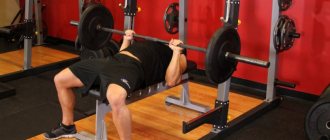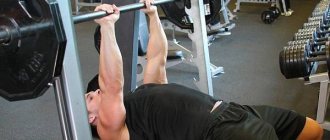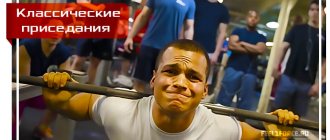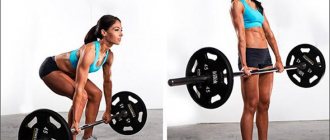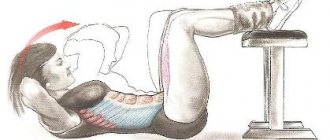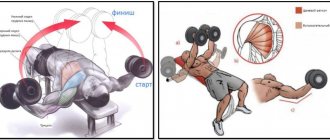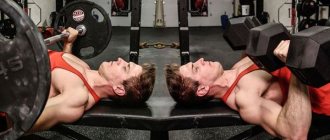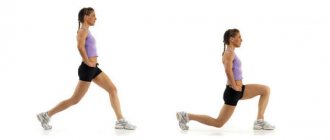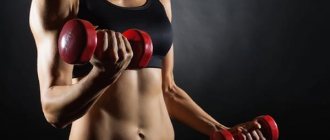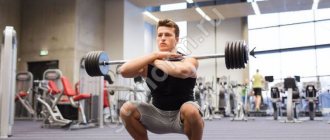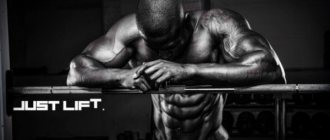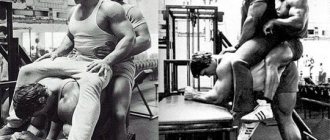French bench press: video
Description and benefits of the exercise
The exercise is considered the most dangerous variation of the French press. There is a high risk of elbow injuries. It should be performed for less than three months in a row. At the same time, select a weight of the apparatus with which you can perform at least 10 presses. Most often, men use 20 kg weights, and women use 10 kg.
Working on the triceps ensures that your arms increase in volume. Girls will be able to effectively pump up one of the most problematic areas. The shoulder joint will become much more stable. The arm muscles will become much stronger.
French bench press with a barbell lying on a bench: execution technique
- Lie down on a flat bench. Press your feet to the floor. Grab the barbell with an overhand grip. Pull the bar back. Watch the position of your hands: they should be perpendicular to the floor. Only the elbow joints are involved in the movement.
- Take a breath. Lower the bar. The bar should be level with your forehead.
- Don't allow pauses. Exhale and immediately return to the starting position.
Technique - French bench press
Application of the exercise
To whom . Everyone from beginner to master.
When . It is recommended to perform a split workout on the back and triceps in the middle.
Work directly on your back. Then do a heavy compound triceps exercise. For example, dips. Afterwards, perform a French bench press.
Number of repetitions . 4 sets of 12-15 repetitions. 60-90 seconds – rest between approaches.
Exercise takes a sufficient amount of energy. For athletes of all levels of fitness, French presses with a barbell are part of a comprehensive arm workout. The best option would be to perform the exercise immediately after bench press with a close grip.
Types of French press and technique
Option 1: Bench Press
From the name it is clear that to perform this exercise we must lie down on some surface. Performing a French press in this style is much easier, since the back is fixed and you don’t have to worry about stabilizing the torso. Therefore, we can focus only on the triceps work. This exercise is also very suitable for beginner bodybuilders, as it is the easiest to perform. Another point is the angle of the bench. If you do the bench press on a horizontal surface (press bench, on the floor), then the maximum load will fall on the long head of the triceps. If you set the bench at an angle of 45° or higher, the emphasis will shift to the lateral head. Of course, you won’t notice quite a big difference, but by doing it at different angles you can work out your triceps as much as possible.
Technique:
- Lie down on a bench at the angle you choose. If they are all busy, you can lie down on the floor, you won’t notice much of a difference. Take the barbell in your hands (either yourself or have a partner hold it), with a shoulder-width grip. The shoulder blades are pressed to the surface on which you are lying, your feet are on the floor. The head is pressed, lies closer to the edge of the bench.
- Raise the barbell up. This is a very important point. If you perform the variant to the nose, then keep your hands perpendicular to the floor. If behind the head, the hands should be shifted slightly towards the chin, as shown in the picture.
- We inhale and bend our arms at the elbow joint, thereby lowering the barbell to the point we have chosen, the nose or behind the head.
- After completely lowering the bar, immediately exhale and straighten your arms and return them to their original position. Don't make sudden movements.
There is nothing complicated in the technique, but you still need to work on it. Also, the exercise puts a lot of stress on the elbows, and if you do it in any way, you can injure them.
Option 2: Seated Press
This option is a more complex form of performing the French press. Here you will have to monitor not only the work of the triceps, but also the position of your body. You can, of course, simplify it a little and install a backrest so your back rests against it. The choice depends on your level of training. We will lower the barbell behind the head, thereby increasing the range of motion, which will increase the load on the triceps. Also by doing this exercise while sitting, we will engage all 3 heads of the exercise. For beginners, doing a seated French press at the initial stage will be difficult until a clear neuromuscular connection (connection between the brain and the working muscle) is established. But if your level is above average, then feel free to proceed with this option.
Technique:
- We sit on a bench for a press, our feet rest on the floor. We grab the barbell and lift it above our head. Grip shoulder-width apart. The back is straight, there is a slight arch in the lower back (if you do the option with a back support, then the shoulder blades are pressed against the back, the lower back is also arched). The gaze is directed forward.
- We take a breath and begin to bend our arms at the elbow, bringing the barbell behind our head.
- Without pausing while exhaling, return the bar to its original position, fully straightening your arms at the elbow.
Make all movements smoothly, controlling the stretching and contraction of your triceps.
Option 3: Standing Press
This is the most advanced of all options. Of course, there is no big difference in it from the others and even the execution technique is the same. But still, to do a French press in this style, you need extreme concentration on the position of the whole body. We can rightfully say that this version of the exercise is professional and the triceps work in it to the maximum. Firstly, because the work occurs over an extremely large amplitude of movement. That is, it stretches the triceps at the bottom and fully compresses it at the top. Secondly, cheating is possible (additional repetitions involving assistant muscles), of course to a reasonable extent and, most importantly, consciously. It will help lift more weight and increase our load progression. Of course, I do not recommend using it, as you can get very seriously injured. Therefore, it is better to leave it for professionals or for people who take on these risks.
Exercise technique:
- Stand straight, feet shoulder-width apart. Feet rest on the floor. Raise the barbell above your head.
- After inhaling, bend your elbows and lower the barbell behind your head.
- As you exhale, straighten your elbows, returning the bar to its starting position.
In this option, do everything as concentrated as possible.
Various exercise options
The main option is to lie on a bench with an EZ-shaped barbell. The most common exercise. Considered effective and safe.
French bench press with EZ-shaped barbell
French bench press on the floor
If all the benches in your gym are occupied. Perform extensions while lying on the floor. You won't find any significant differences in training.
Performing an exercise on an incline bench
This option will allow you to better work and stretch the outer (lateral) head of the triceps.
Incline press video
French straight barbell bench press
You can use a straight bar if you don't have an EZ bar. Be careful with your wrist joints. The load and the chance of injury increases significantly. Be sure to use bandages to secure your hands.
Recommendations
- Pay attention to the position of your elbows. For maximum results, try to keep them as close to one another as possible. In addition, they must be motionless. A different hand position makes the exercise much easier. Tension can be redistributed from the posterior triceps to the latissimus dorsi muscles.
- If you experience pain in your wrists, wear wristbands or use elastic bandages.
- Watch your breathing. When lifting the barbell, you need to exhale through your mouth. Inhale through your nose as you return to your original position.
- If you have pain in your elbow joints, you should avoid performing the French bench press.
- It is preferable to use an EZ-shaped bar. A curved projectile is better suited due to the habitual movement in the joints. This bar allows you to specifically work the triceps, reducing tension from the forearms and elbow joint.
- Hold the projectile with a medium grip. A narrow hand position will prevent you from performing the exercise correctly. A wide grip can have a negative impact on your health.
- Don't make sudden movements.
- Don't put your feet on the bench. This position is unstable and carries the risk of injury.
- If you don't have a bench, you can do the French barbell press on the floor. When replicating a bench press, ask someone for help.
When lowering the bar behind your head, the long head of the triceps is included in the work. It is this muscle that most often causes difficulties in pumping it. But to train the medal and lateral heads of the triceps, you should lower the barbell to your forehead.
Additional chips
- Use an incline bench. This version of the exercise will become even more difficult to perform.
- Don't let your whole body help.
- Use special straps or gloves to increase grip strength. This will increase the load level.
- Straighten your arms at the elbow joints completely. This will allow you to increase your range of motion.
Common Newbie Mistakes
- Using heavy sports equipment has a negative impact on the technique. There is a risk of injury.
- Unfixed shoulders lead to load displacement.
- Lifting the body from the surface of the bench entails a redistribution of the load.
Barbell or dumbbells?
The French press with dumbbells is done to work on the relief of the arms. This version of the exercise involves all the triceps bundles. The option of movement by inertia is excluded. However, the French barbell press is more popular due to the ease of mastering the technique.
Notes
If you're using an EZ bar, try doing static extensions. Bend your arms at right angles. Fix your position. To increase muscle mass, hold the position for 40 seconds. When performing strength training, reduce the time to 8 seconds.
To take care of your elbow joints, do not perform several types of French presses during one session. Take breaks to allow your muscles to recover. Triceps strength is especially important for athletes involved in basketball, tennis, and martial arts.
Did you like the article? Subscribe to us on social networks and be the first to know about new products!
French presses from different positions
Bench press
The French bench press is performed using the following technique:
- We are looking for a horizontal bench. A slanted one will also work if you straighten it completely. It is advisable to place a towel or T-shirt under your head.
- It is more convenient to take an EZ bar. It has a special curved shape that allows you to rotate your arms in a certain way, pumping either the outer or inner parts of the triceps. Most often, the bar is grabbed with a narrow grip.
- We put the bar on our knees, lie down and take it behind our head.
- Slightly bent arms at the elbows go behind the head so that the elbows are at forehead level. This is the starting position for this exercise.
- Let's clarify the grip: hands are located on the sides of the central loop of the EZ bar, with palms facing away from you (direct grip).
- We bend our arms so that the bar is near the top of the head (almost touching).
- We slowly extend our arms, but do not straighten them completely; it is not recommended to “snap” the elbow joints.
- We do 10 warm-up repetitions. Then we lower the barbell onto our belt, sit down and put it on the floor. If you have a partner, they can help you grab the barbell and lower it to the floor.
Exercise technique (GIF).
The French bench press with dumbbells is done in exactly the same way, only the arms are turned a little differently: you grab the handles of the dumbbells so that they are parallel to each other.
Important technical details:
- You should try to move your elbows as close as possible. When they spread to the sides, the load moves from the rear triceps to the lateral, or generally to the latissimus dorsi muscles.
- If your wrists hurt (this may be because they bend significantly during the French press), you need to wear wristbands or wrap your wrists in bandages.
The French bench press with dumbbells makes sense to do when all the bars are occupied.
Seated press
The seated French press is performed on an incline bench, the back of which is set at a right angle.
To do the exercise correctly, it is best to take dumbbells.
The difficulty of performing with the bar is the awkward position of the hands. When doing a seated French press with a barbell, it is difficult to get your arms in such a position that your shoulders are perpendicular to the floor. Usually they are slightly tipped forward, and the exercise begins to resemble a seated barbell press.
If you decide to use a straight or EZ bar, it is better to do it lying down; if you do it while sitting, take dumbbells.
Option with two dumbbells
Technique:
- Take 2 dumbbells, rotate them so that the weights are in front and behind, your hands should be oriented with your palms facing each other.
- Raise your arms with dumbbells slightly bent at the elbows above your head. Try to set the angle of your shoulder to the floor at 90 degrees.
- Bend your elbows so that your shoulder does not move to the sides. Move the dumbbells behind your head to an acute angle at the elbow.
- Lift the weight back to the original position.
Do 10 warm-up reps with a light weight, then pick up a work rep and perform 3-4 sets of 8-10 reps. Make sure that your elbows do not move out to the sides.
If you rotate your arms differently, the dumbbell plates will prevent you from lowering the weights to a sufficient angle behind your head. Therefore, the hands are oriented exactly as noted above.
Option with one dumbbell
With one dumbbell you should do a French press while standing or sitting on a bench.
The technique is like this:
- Take the dumbbell in your right hand. We bring it up, the shoulder is strictly perpendicular to the floor.
- We turn the arm so that when bending the dumbbell goes towards the head, and not strictly back.
- We support our right hand with our left hand so that it does not move to the sides during the exercise.
- We do 10 warm-up repetitions for each arm, take the working weight and perform 3 sets of 10 times until failure.
The weights here are light, but since this exercise is the last one on triceps day, you will have little strength. We do it through the burning sensation, through fatigue. If necessary, reduce the weight each approach, or ask a partner to help you return the dumbbell to the starting position above your head.
Another way to work with one dumbbell, but with two hands:
- The exercise will resemble a seated pullover. We grasp the dumbbell with both hands by the plate, passing it between the index and thumb of each hand.
- We lift the dumbbell over our heads, trying to keep our elbows closer to our ears and not turn them outward.
- Bend your arms, lowering the dumbbell behind your head. We raise. Do this 10 times to warm up if you haven’t warmed up yet. With the working weight you need to do 10 repetitions in 3 approaches.
You can do a French press with dumbbells while standing.
Standing press technique
The standing French press can also be performed with a barbell or dumbbells, but the latter option is more convenient. Since the technique with dumbbells was discussed in the previous case, here we will analyze the barbell.
The technique is as follows:
- Grab a barbell and place your feet shoulder-width apart.
- Straighten your shoulders, move your pelvis back.
- Look forward, do not tilt your head!
- Raise the barbell so that your elbows point up and your shoulder forms a right angle with the floor.
- Elbows do not need to be spread apart or brought together. They must be parallel to each other.
- You shouldn't straighten your arms completely either. Lower the weight behind your head as far as possible. Bring it back.
- If you haven't warmed up, do 10 reps with an empty bar (for girls) or a light weight. Next, set the working weight and perform 3 sets of 10 reps.
The standing French press is not the most common variation of this exercise. It is inconvenient because the spine receives extra load. It should be done when there is little space in the gym or all the benches are occupied.
French bench press
Despite its name, the French press is not a press in the sense of the word as we are used to. In this exercise, the emphasis is on extending the arms using relatively light weights, which determines its main effects, which are giving shape to the lower sections of the triceps, and then increasing its size. Here the lateral and median bundles work most intensively, which determines the purpose of using the exercise in bodybuilding - drawing muscle fibers, their detailing and maximum separation.
Execution technique
- Lie down on a horizontal bench and place your feet firmly on the floor. Raise your arms straight up, they should be perpendicular to the floor, and ask your partner to hand you the barbell.
- It is better to take a barbell with an EZ bar, or if it is not in your arsenal, then it is not a sin to perform the exercise with a simple barbell with a straight bar.
- Grab the bar with an overhand grip and press the barbell up. Fully align your arms with the barbell and move them back (toward the top of your head) 40-50° from the vertical. This is the starting position.
- Take a deep breath and hold your breath. Keeping your upper arms (shoulder to elbow) locked, slowly bend your elbows and lower the barbell behind your head toward the back of your head. From below, the angle at the elbow joint should be 90°.
- When you reach the bottom point, don't stop moving! Quickly change the course of movement and, straightening your elbows, return the bar to its original position. When lifting the barbell, do not exhale or extend your elbows forward. The part of the arms from the elbow and above should remain secured until the end of the set.
- As soon as you straighten your arms as much as possible, pause for a couple of seconds, exhale and use auxiliary force to tighten your triceps even more.
How to do a French press correctly
To begin with, we will look at the most popular version of the French press - lying on a horizontal bench. It allows you to take more weight than when working standing or sitting, and perfectly load the triceps.
It is better to perform this exercise with a curved or EZ bar. This puts your wrists in a better position (at an angle) and takes less stress. If there is no such bar, you can do it with a straight bar.
How to take the starting position
Place a barbell with the desired weight on the edge of the bench. Then lie on the bench on your back, raise your hands behind your head and grab the apparatus. Move your arms with the barbell forward to a position above your shoulders.
With your feet on the floor, move further up the bench so that your head extends slightly over the edge.
Lower your shoulder blades, press your shoulders against the bench and lock this position.
How to do the exercise
Move your arms towards your head so that they are not perpendicular to the body, but at an angle. Due to this position, the torque in the elbow increases and the triceps receives more load.
From this point, bend your elbows smoothly and under control, lowering the barbell behind your head. You can lower it to the level of the bench or a little lower - as far as joint mobility allows.
Extend your elbows as you lift the barbell to the starting position. Do not move your shoulders or lift your shoulder blades off the bench - this will involve other muscles in the work and take the load away from the triceps.
During flexion and extension, do not move your elbows - they should remain approximately in the same place.
Application
Intended for: Everyone, from beginners to professionals.
When: At the beginning of a triceps workout. But first, do close-grip bench presses or push-ups the French bench press After the French bench press , perform downward presses by straightening your arms at the elbows with weights behind your head and straightening your arms with bent over weights.
How much: 3-4 sets of 10-15 repetitions.
Sports instruction: In weightlifting, the French bench press is needed for general improvement of the triceps, but primarily for maximum load on its long head in order to emphasize and lengthen its bottom. The wider this triceps head, the more powerful the upper arm appears when viewed from the side.
Extension of the arm raised behind the head in the elbow joint, performed due to the work of the triceps, is the main movement in various sports: basketball (throwing the ball from behind the head), volleyball (passing the ball, athletics (pole vaulting), martial arts (strikes) edge of the hand from top to bottom).
Correct technique
To begin, select “your” weight for the barbell or dumbbells. This is the amount of load that you can withstand for a given number of repetitions. If your exercise technique requires a large number of repetitions, then the load weight should be reduced. On the contrary, with a minimum number of repetitions, the weight of the weight must be increased.
When lifting, the arms must be fully extended at the elbow joint, otherwise the effect will not be the same. So, if you are armed with dumbbells, then the French press is performed as follows:
- lie down on a horizontal bench;
- bend your arms with dumbbells in each at the elbows, turn them towards each other and place them on both sides of your head;
- press upward above you, straightening your arms at the elbows;
- do several approaches and repetitions.
The exercise works the main muscles (triceps) and auxiliary muscles (lats and trapezius). Alternatively, you can lower your hands with dumbbells to your forehead to train the medial and lateral muscle bundles.
Placing your hand behind your head develops a long bun. Numerous videos give a clear picture of how to technically perform this simple exercise correctly.
Pros of exercise
- Helps to work out all the bundles of the triceps brachii muscle, developing them evenly.
- Forms the volume of the hands and also emphasizes the relief.
- The exercise can be performed either independently (on blocks or with special racks for the French bench press), or with an assistant who will support free weight during the last repetitions.
- The exercise can be performed at home; it is enough to have at least one dumbbell or barbell.
- Grip options will help reduce pain in the wrist or elbow joints, which makes the execution accessible and more effective.
How to do a French press correctly: execution options
French barbell press
The technique of performing the French bench press with a barbell is aimed at working all the heads of the triceps brachii muscle.
- When lowering the barbell to the forehead, the medial and lateral heads are subjected to greater load.
- When placing the bar behind the head, the head is long. It can be performed with either a straight bar or a curved bar.
The choice of bar will depend on the sensations in the joints; to relieve stress on the wrist joints, place your palms closer to each other.
- Place the bar on special French press racks, or hold the bar on your chest, place your palms on the bar shoulder-width apart, and slowly lie down on your back. At the bottom point, lift the barbell up, fully straightening your elbows.
- Press your lower back against the bench; if this is not possible, place your feet on the bench, thus removing the deflection of the lumbar region.
- Hold the barbell above your shoulders without throwing your elbows out to the sides.
- As you inhale, lower the barbell to your forehead, but without touching it. Movement occurs only at the elbow joint.
- As you exhale, straighten your elbows to the end, without moving them as you lift them to the sides.
Execution options. If discomfort occurs in the elbow joints , move your elbows slightly to the sides from your shoulders, stabilizing the position. Also, the French bench press can be performed with an ez-bar, choosing a comfortable grip width.
French press with dumbbells
This technique is performed with two dumbbells; the exercise works the entire triceps, evenly distributing the load on all muscle heads. The elbow muscle is also involved. A comfortable neutral grip on dumbbells will reduce stress on your hands.
- Take light dumbbells in your hands.
- Lie slowly on your back and raise your arms straight above your shoulders to a vertical position.
- Hold your hands with a neutral grip and the dumbbells parallel to each other.
- As you inhale, lower the dumbbells parallel, working in the same plane, without moving your elbows to the sides.
- As you exhale, straighten your elbows completely.
Seated French press with ez bar
Performing a bench press while sitting on a bench with a low back will help stabilize the position of the lower back, preventing the body from swaying, and making the technique easier. This exercise can also be performed standing, the main thing is not to sway and hold your torso, tensing the abdominal and lower back muscles. The exercise technique develops the triceps, but to a greater extent the long and lateral heads.
- Place your palms on the curved bar in a narrow overhand grip position.
- Sit on a bench, press your lower back to the back.
- Raise the bar above your head, keep your arms straight.
- Without twisting your hand, while inhaling, lower the bar behind your head, keeping the shoulder and elbow joints motionless. The shoulders remain on the sides of the head, only the forearms are lowered.
- As you exhale, straighten your elbows and return the bar above your head.
Seated French press with two hands
This French press technique is also performed while standing. Holding 1 dumbbell with both hands, you can get a load on the long head of the triceps, thanks to the vertical position of your arms. The additional muscle is the olecranon.
- Sitting on a bench, rest your lower back against the back.
- Place your hands under the dumbbell plate from below.
- Raise your arms above your head to a vertical position, keeping your elbows close to your head.
- As you inhale, lower the dumbbell to the back of your head without moving your elbows and shoulders.
- Exhale and extend the dumbbell overhead.
Option #2. One-arm extension (press) with a dumbbell
This exercise can replace the French press. Performed in both sitting and standing positions. One-arm extension will work the triceps and anconeus muscles. The vertical position of the arms contributes to a greater load on the long head of the triceps muscle.
- While sitting or standing, hold a dumbbell with one hand, raise your arm straight up and stabilize your shoulder position.
- As you inhale, lower the dumbbell behind your head without moving your elbow to the side. Tighten your abdominal muscles to maintain your lower back position.
- Exhale as you extend your arm.
- The same movement is performed on the other side.
What other variations of the French press are there?
Lying on a bench with dumbbells
The option with dumbbells is perceived as more comfortable for the shoulders and elbows due to the rotation of the wrists, but at the same time it loads the muscles well due to instability.
Turn your hands with your fingers towards you and perform the exercise using the same technique as with a barbell.
Keep in mind that with dumbbells you will have to take less weight, since the force is spent not only on extending the elbows, but also on stabilizing the shoulders.
Lying on the floor with a barbell or dumbbells
This option is suitable for those who want to limit the range and do each repetition clearly at the same amplitude.
The rules of execution are the same as in the bench press, only here you lower the barbell or dumbbells until they touch the floor each time.
Standing or sitting with a barbell or dumbbells
In this version, the body is perpendicular to the floor, and the range of movement of the arms is greater than if you were doing the exercise while lying down. On the one hand, you will take less weight, on the other hand, you will load the muscles more due to the greater amplitude.
Alternate this exercise with an option on a bench to give your muscles an unusual load and stimulate growth.
Raise the barbell or dumbbells up with your arms outstretched. Lower your shoulder blades and lock your shoulders. Lower the projectile behind your head to the end of the range, and then lift it back up.
Standing or sitting with a dumbbell in one hand
This design option allows you to achieve maximum range of motion and connect body stabilizers to the work.
Keep your abs tight to keep your core rigid and stable, and don't arch your back. Place the dumbbell behind your head and then straighten your arm. Try not to move your shoulder and only move your elbow.
Standing with one dumbbell in both hands
Here the limbs are closer to each other, which slightly changes the load on the triceps. The variation is more comfortable than the same exercise with a barbell.
Grasp the dumbbell with both hands and lift it above your head. Bend and straighten your elbows, being careful not to move your shoulders.
Sitting on an incline bench with a barbell or one or two dumbbells
Renowned trainer and physical therapist Jeff Cavaliere advises 6 BEST Triceps Exercises (ANATOMY BASED) to perform the incline French press because it prevents your elbows from flaring out and makes the movement safer for your shoulders.
You can do this exercise with one or two dumbbells, or with an EZ bar. The rules are the same: move your hands further behind your head, do not spread your elbows, do not move your shoulders.
On the block
The option on a block simulator provides a constant load on the muscles at all points of the exercise.
Attach a rope handle to the lower block, turn your back and lift the handle above your head with outstretched arms. Then gently bend them, lowering your forearms behind your head, and lift them back up.
To maximally work out the triceps, it is advised to not only straighten your arms at the elbows at the top point, but also turn your wrists outward.
With expander
If you are working out at home, you can do the exercise with an expander. Step on the loop of the expander with your foot, and lift the other end up with outstretched arms. Bend and straighten your elbows, trying to keep your shoulders at the same level.
French press: the most effective exercise? How to save your elbows from injury?
Is it true that the French press is the most effective for training the triceps? Or is it better to concentrate on more basic, multi-joint exercises such as close-grip bench press or parallel bars? Today I will answer these questions, we will talk about how to avoid injuries that come with the French press, and we will also reveal some secrets of the French press that no one else will tell you about.
The problem with triceps is that in more than 50% of trainees, the load when performing basic exercises is eaten by non-target muscles.
When doing close-grip bench presses, athletes often complain that the load goes to the front deltoids, pectoral muscles, anywhere, but not to the triceps. Also on the uneven bars, no matter how you perform this movement, the pectoral and shoulders absorb almost the entire load and the muscles do not receive the much-needed mechanical tension.
Let me remind you that according to the research of the American scientist Chris Beardsley, mechanical tension is the main factor in muscle growth. Therefore, if the target muscle does not receive a strictly defined mechano-impulse, we cannot even dream of strong and developed triceps.
At the beginning of my training journey, I read in the literature that the triceps are well loaded in all basic exercises, including the bench press. So I didn't worry about my triceps and focused on the bench press and bars.
Imagine my disappointment when I realized that my arms were not growing from the indirect load! From pull-ups, only my back grew, and from the bench press only my chest! The biceps and triceps did not grow a millimeter, the arms remained just over 30 centimeters. Then I “hit” two of the most effective exercises for the arms: standing arm curls with a straight barbell and the French bench press.
My biceps and triceps started to grow, and I managed to increase my arm circumference by 12 cm in just one year! Of course, we are talking about natural bodybuilding; I started performing professionally much later.
A few years later, I got up to 70 kilograms on the French press, and both my elbows started to hurt terribly! The pain was such that I could no longer perform French at all, even with a 20 kg barbell! Recovery took almost a year, and during this entire period I could only train my triceps with basic exercises. As a result, there was a slight “rollback” in the development of this muscle.
This does not mean that it is the weight of 70 kg that is dangerous. For some it will be 50 or 80 kg, you need to use the principle of an individual approach. However, these problems can be completely avoided by reconsidering your attitude towards the exercise and using the tips below.
Helpful Tips for Performing the French Press
- By performing this exercise while lying on the floor, you will be able to lift the barbell on your own and will not need the help of a partner.
- The French press with dumbbells may seem like a more comfortable movement for your elbows, but in my opinion it is a less powerful and more dangerous exercise (perfect control is needed).
- Do the French while lying on the step platform, then the barbell will not touch the floor with the weights, but it will be as comfortable as possible for you to perform the exercise.
- Lower the bar not to your forehead, but to the top of your head.
- Pull your arms back before you begin the exercise, and keep them there the entire time so your triceps don't lose weight when the bar reaches the top of the movement.
- Do 3 working sets of arm extensions on the upper block for 8-10 repetitions “to failure”. Then (with the second exercise), begin to perform fr. bench press
- Unlike other strength exercises, where progress is maximized at 6-8 repetitions, you perform the French press for about 10-12 repetitions, thereby reducing weight and injury.
- The most effective French press, when working with a curved barbell with a narrow grip.
- The most traumatic style of fr. bench presses in a standing or sitting position. French on an incline bench is less dangerous. The most gentle versions of the French press are head down on a reverse inclined bench, or on a horizontal bench.
French press technique
- Lie down on a flat French press bench or a regular bench.
- Remove the barbell from the racks or accept it from your partner’s hands
- Bend your arms bringing the bar to your forehead or to the top of your head (depending on the style of execution)
- Extend your arms completely. In the classic version, the bar will stop above your forehead, in the improved version, the arms are pulled back, the bar is slightly behind your forehead.
- Bend your arms slowly and inhale, straighten with a powerful movement as you exhale.
Watch a video demonstrating all the nuances of the French press technique in a lying, sitting and standing position. This will help you master the technique of performing the movement.
I also suggest that you study the technique of such exercises:
Bench press, dumbbell press, biceps with barbell, biceps with dumbbells, press with plate, leg raises, pull-ups, one-arm rows, fr. bench press, standing arm extensions, standing dumbbell swings, lying dumbbell swings, seated dumbbell press, barbell squats, deadlifts, calf raises, hyperextensions.
French press. We study all the subtleties and secrets.
Greetings, my dear kachatas and fitness girls! Today we will get acquainted with one overseas exercise, whose name is the French press.
Why it's called that, I have no answer, but I'm sure there's an Oscar-worthy story behind the title. After reading, you will learn everything about the muscle atlas, the benefits and technique of doing the press, we will also make some comparisons and find out which exercise is the best for developing the triceps.
So, take your seats, let's go.
French press: what, why and why?
Almost every gym goer is familiar with the exercise known as the French press. I would even say that it is the most popular and frequently encountered when training the triceps brachii muscle. Beginners can often be found doing the “French”; girls also do not disdain this exercise. Due to such total popularity of the bench press, I think it will be useful to go through its execution technique and practical features. Actually, let's get down to business.
Note:
For better assimilation of the material, all further narration will be divided into subchapters.
Muscle atlas
The exercise is single-joint, i.e. One joint (elbow) takes part in the work, which performs extension work. The target muscle group is the triceps (long, lateral and medial heads), the assisting muscles are the pectorals, shoulders and forearms. Lying arm extensions with a barbell are mostly aimed at working the inner part of the triceps.
The complete muscle atlas looks like this:
Advantages
As for the benefits of the exercise, by doing it you can get:
- increase in muscle volume of the arm;
- tighten the “jelly” under the arms so that nothing dangles (relevant for women);
- isolation of the triceps brachii muscle;
- greater variability in triceps training;
- better stability of the shoulder joint;
- greater flexibility and functionality of the arm muscles;
- increasing performance in sports using arm strength (tennis, swimming, volleyball);
- a relatively simple technique with high efficiency.
Agree, quite an impressive list for such an unprepossessing isolation exercise.
In addition to the above, it can also be noted that the French press/triceps extension is very popular in the celebrity crowd, in particular, the following were seen performing them:
- actress Halle Berry, in preparation for filming the film “Catwoman,” used extensions to train her arms;
- Kim Kardashian uses extensions to “tone” her arms;
- singer Rihanna often includes extensions and French presses in her arm workouts;
- actor Mark Wahlberg uses triceps supersets, which include lying arm extensions;
- Actor Chris Hemsworth used the French press to develop his triceps for the film “Thor.”
Let's go further and now talk about...
Execution technique
The French press is a technically simple exercise, but you can often see how many still manage to make mistakes in it. Therefore, to avoid any mistakes, let’s take a step-by-step look at the technique of performing the “French style”.
Step #0.
Find a moderately narrow bench in the gym, lie on it with your back, and take a curved EZ bar. Straighten your arms above your chest, grasping the barbell with a medium grip at the break point of the bar. Your arms should be perpendicular to your torso and floor. Do not spread your elbows, but tuck them inward. This is your starting position.
Step #1.
As you inhale, slowly lower the weight by bending your elbows until the bar touches your forehead. During the movement, keep your shoulders/elbows stationary, moving only by bending your arms. As soon as the bar touches your forehead, as you exhale, use your triceps to press the weight upward, returning the bar to its starting position.
Step #2.
Repeat the specified number of times.
In the picture version, the French press looks like this:
The exercise offers many schemes for its implementation, here are some of them:
- with wide/narrow hand position;
- with dumbbells;
- Per head;
- lying on a bench near a block with a rope handle.
Secrets and subtleties of implementation
No exercise is complete without its technical nuances, so remember:
- initially, while holding the bar, you can slightly tilt your arms away from the vertical, this will increase the impact on the triceps at the top point;
- make sure that the load falls on the triceps brachii muscle and is not spread to other muscle groups;
- do not spread your elbows too far to the sides, keep them tucked inward throughout the entire movement;
- do not move your shoulders/elbows during the press, fix them in one position;
- by placing your feet on the bench, you isolate the triceps more;
- do not get into the “bridge” position in the exercise;
- feel every millimeter of amplitude, performing the movement slowly and under control;
- do not lower the barbell too low (behind your head) - this will pull your body and lift your lower back off the bench;
- at the end points of the amplitude, take a short static pause for 1-2 counts;
- perform the exercise with adequate weight more than once every 2 weeks;
- If you have problems with your elbows, then it is better to avoid this exercise.
We seem to be done with the theory. Now let's compare several triceps exercises and find out which one is better.
Reverse push-ups VS close grip bench press VS French press. Who will win?
These three manual mass-building exercises have been researched to see which one works best on the triceps. During the study (Professor A. Tesch, USA), the electrical activity of muscles was measured using MRI when performing these exercises.
Here are the results obtained. When performing the French press with an EZ bar, the long (largest) head of the triceps received the greatest load, and to a lesser extent, the lateral and medial heads. When performing bench presses with a narrow grip, the medial and lateral muscles were loaded the best, while the long muscle was loaded worse. Conclusion: “pairing” these two exercises allows you to effectively load all three heads of the triceps.
Also an extremely effective exercise that combines the same loading effect on all 3 heads of the triceps at once are dips and reverse push-ups from the bench. Another study from the US Institute of Biomechanics ( 2011 ) found that the best activation exercise for all three heads of the triceps was push-ups in the triangle position.
Thus, it turns out that these exercises are extremely effective in terms of volumetric impact on a muscular unit, and they should be placed first in training the triceps brachii muscle, and only then finish off the triceps on block exercise machines.
Actually, this was the last information that I would like to share, let’s summarize.
French press with one dumbbell
The last variation of the French press is the dumbbell elbow extension. In this case, you will be working the long head of the triceps. This, by the way, is a variant of exercises that can be done while sitting on a bench, but can also be done while standing. In this case, the lower back does not bend back, and the stomach remains retracted. The shoulders also do not round with a flat chest.
- Take a dumbbell in your hands and hold it behind your head.
- As you inhale, lower it by the shoulders, and as you exhale, lift it up.
- In this case, the elbows do not spread to the sides, and the shoulders are kept strictly vertical. The projectile goes down as deep as possible, the arms work at full amplitude.
- You can take a slightly lighter weight and hold the dumbbell in one hand. This will allow you to focus on each tricep. In this case, with your second free hand you can support the working limb by the forearm to fix it.
- In principle, all exercises with dumbbells can be done while standing. If you want, then take the disk.
There are also special machines for working the triceps, but they are not available in every gym.
Well, my persistent rockers! We loaded the triceps to the fullest extent and now we sit and think, where can we find more interesting and effective exercises for other muscle groups? I always have answers to any questions, so I’ll immediately send you the link:
We go to this page and immediately find a lot of useful and important information for creating an ideal body.
This is all I want to tell you about the French press, but, of course, not everything I can tell you about life in a sports style. Come visit, it will be interesting!
